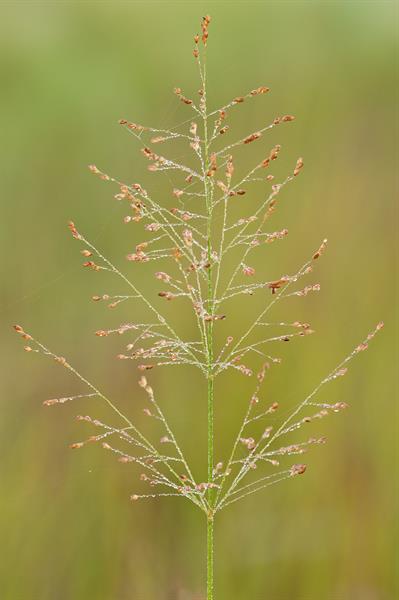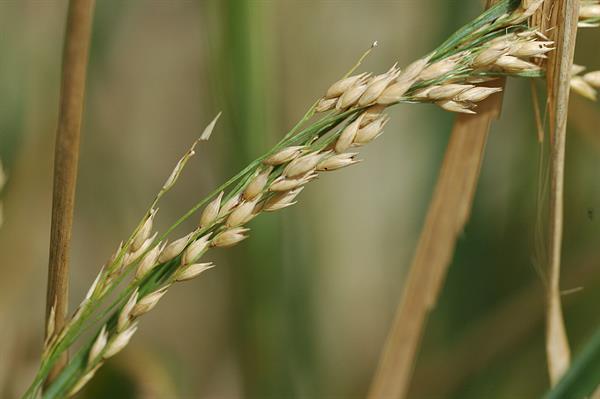
Contributed by Richard J. LeBlond
There has been considerable controversy over the generic limits of Panicum. In its broader past conceptions, it has been considered to include (in our area) taxa sometimes and variously segregated as Brachiaria, Dichanthelium, Eriochloa, Janochloa, Kellochloa, Paspalidium, Phanopyrum, Steinchisma, and Urochloa. All were originally recognized based on morphological characteristics, to which have recently been added anatomical, chemical, and other evidence. Phanopyrum and Dichanthelium are the only segregate groups with C3 photosynthesis. Eriochloa and Urochloa (including Brachiaria) have C4 photosynthesis, with PEP-ck decarboxylation. Panicum and Paspalidium have C4 photosynthesis, with NAD-me or NADP-me decarboxylation. Steinchisma, in addition to its unusual expansion of the palea, apparently has a peculiar photosynthetic pathway, described by Crins (1991) as "intermediate between" C3 and C4 photosynthesis; "the leaves have Kranz anatomy, but there are fewer organelles than usual in the outer sheath."
We agree with Hansen & Wunderlin (1988) that “Dichanthelium is as ‘good’ a grass genus as many others (e.g. Brachiaria, Sacciolepis, and many more in other tribes)”. Despite arguments to the contrary, there is little doubt that Dichanthelium is a natural group. Zuloaga, Ellis, and Morrone (1993) argue against the recognition of Dichanthelium as a genus, preferring to treat it as a subgenus under Panicum. They state, however, “within Panicum, Dichanthelium can be distinguished at the subgeneric level by the following set of characters: lax inflorescences; ellipsoid to obovoid spikelets; upper glume and lower lemma usually 7-11 nerved; upper anthecium apiculate or shortly crested, and simple papillae on the lemma and palea. Anatomically, all species are non-Kranz or C3, with the outer parenchymatous sheath lacking specialized chloroplasts”, etc. The argument that Phanopyrum also has C3 photosynthesis does not materially affect the issue of the taxonomic rank at which to recognize the groups.
We also agree with Hansen & Wunderlin (1988) that “the acceptance of Dichanthelium provides a more consistent generic classification”. It offers conveniences, as well, in our area, where Dichanthelium and Panicum are readily distinguishable from each other, and the combined genus would be very large, indeed.
ID notes:Describe differences between Panicum and genera removed from it. Describe collection methods and character analysis.
Ref: Crins (1991); Darbyshire & Cayouette (1995); Delfini et al. (2023); Freckmann & Lelong (2003c) In Flora of North America Editorial Committee (2003a); Haines (2010); Hansen & Wunderlin (1988); Landge & Shinde (2021); LeBlond (2020); Lelong (1986); Sorrie (2018b) In Weakley et al. (2018a); Zuloaga (2022); Zuloaga & Aliscioni (2023); Zuloaga & Morrone (1996). Show full citations.
Hover over a shape, letter, icon, or arrow on the map for definition or see the legend. Data for arrows not developed for genera and families which may have species only occurring outside the flora area.
 © Gary P. Fleming | Panicum virgatum var. virgatum | Original Image ⭷
© Gary P. Fleming | Panicum virgatum var. virgatum | Original Image ⭷ © Lowell Urbatsch | Panicum dichotomiflorum var. dichotomiflorum | Original Image ⭷
© Lowell Urbatsch | Panicum dichotomiflorum var. dichotomiflorum | Original Image ⭷ © Keith Bradley | Panicum virgatum var. cubense | Original Image ⭷
© Keith Bradley | Panicum virgatum var. cubense | Original Image ⭷ © Gary P. Fleming | Panicum flexile | Original Image ⭷
© Gary P. Fleming | Panicum flexile | Original Image ⭷ © Keith Bradley | Panicum bisulcatum | Original Image ⭷
© Keith Bradley | Panicum bisulcatum | Original Image ⭷ © Lowell Urbatsch | Panicum dichotomiflorum var. dichotomiflorum | Original Image ⭷
© Lowell Urbatsch | Panicum dichotomiflorum var. dichotomiflorum | Original Image ⭷ © Keith Bradley | Panicum amarum | Original Image ⭷
© Keith Bradley | Panicum amarum | Original Image ⭷ © Gary P. Fleming | Panicum amarum | Original Image ⭷
© Gary P. Fleming | Panicum amarum | Original Image ⭷Feedback
See something wrong or missing on about Panicum? Let us know here: (Please include your name and email if at all complicated so we can clarify if needed.)
Cite as...